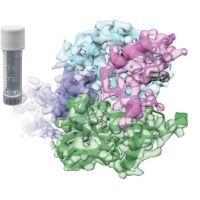Specification
| Description | Recombinant protein from the full-length sequence of Homo sapiens NLR family pyrin domain containing 1 (NLRP1), transcript variant 1 (NM_033004). |
| Organism | Homo sapiens (Human) |
| Expression Host | Human Cells |
| Tag Info | His or DYKDDDDK. Please contact us if you need further information or require specific designed tag. |
| Purity | Greater than 90% by SDS-PAGE gel |
| Uniprot ID | Q9C000 |
| Entry Name | NLRP1_HUMAN |
| Gene Names | NLRP1 CARD7 DEFCAP KIAA0926 NAC NALP1 |
| Alternative Gene Names | CARD7 DEFCAP KIAA0926 NAC NALP1 |
| Alternative Protein Names | NACHT, LRR and PYD domains-containing protein 1 (EC 3.4.-.-) (EC 3.6.4.-) (Caspase recruitment domain-containing protein 7) (Death effector filament-forming ced-4-like apoptosis protein) (Nucleotide-binding domain and caspase recruitment domain) [Cleaved into: NACHT, LRR and PYD domains-containing protein 1, C-terminus (NLRP1-CT); NACHT, LRR and PYD domains-containing protein 1, N-terminus (NLRP1-NT)] |
| Application | Antigens, Western, ELISA and other in vitro binding or in vivo functional assays, and protein-protein interaction studies; For research & development use only! |
| Buffer | Purified protein formulated in a sterile solution of PBS buffer, pH7.2, without any preservatives |
| Endotoxin | Endotoxin level is < 0.1 ng/µg of protein (<1EU /µg) |
| Length | 1473 |
| Molecular Weight(Da) | 165866 |
| Protein Sequence | (The sequence of expressed protein may have some variation from the sequence shown below. Please contact us for the exact sequence.) MAGGAWGRLACYLEFLKKEELKEFQLLLANKAHSRSSSGETPAQPEKTSGMEVASYLVAQYGEQRAWDLALHTWEQMGLRSLCAQAQEGAGHSPSFPYSPSEPHLGSPSQPTSTAVLMPWIHELPAGCTQGSERRVLRQLPDTSGRRWREISASLLYQALPSSPDHESPSQESPNAPTSTAVLGSWGSPPQPSLAPREQEAPGTQWPLDETSGIYYTEIREREREKSEKGRPPWAAVVGTPPQAHTSLQPHHHPWEPSVRESLCSTWPWKNEDFNQKFTQLLLLQRPHPRSQDPLVKRSWPDYVEENRGHLIEIRDLFGPGLDTQEPRIVILQGAAGIGKSTLARQVKEAWGRGQLYGDRFQHVFYFSCRELAQSKVVSLAELIGKDGTATPAPIRQILSRPERLLFILDGVDEPGWVLQEPSSELCLHWSQPQPADALLGSLLGKTILPEASFLITARTTALQNLIPSLEQARWVEVLGFSESSRKEYFYRYFTDERQAIRAFRLVKSNKELWALCLVPWVSWLACTCLMQQMKRKEKLTLTSKTTTTLCLHYLAQALQAQPLGPQLRDLCSLAAEGIWQKKTLFSPDDLRKHGLDGAIISTFLKMGILQEHPIPLSYSFIHLCFQEFFAAMSYVLEDEKGRGKHSNCIIDLEKTLEAYGIHGLFGASTTRFLLGLLSDEGEREMENIFHCRLSQGRNLMQWVPSLQLLLQPHSLESLHCLYETRNKTFLTQVMAHFEEMGMCVETDMELLVCTFCIKFSRHVKKLQLIEGRQHRSTWSPTMVVLFRWVPVTDAYWQILFSVLKVTRNLKELDLSGNSLSHSAVKSLCKTLRRPRCLLETLRLAGCGLTAEDCKDLAFGLRANQTLTELDLSFNVLTDAGAKHLCQRLRQPSCKLQRLQLVSCGLTSDCCQDLASVLSASPSLKELDLQQNNLDDVGVRLLCEGLRHPACKLIRLGLDQTTLSDEMRQELRALEQEKPQLLIFSRRKPSVMTPTEGLDTGEMSNSTSSLKRQRLGSERAASHVAQANLKLLDVSKIFPIAEIAEESSPEVVPVELLCVPSPASQGDLHTKPLGTDDDFWGPTGPVATEVVDKEKNLYRVHFPVAGSYRWPNTGLCFVMREAVTVEIEFCVWDQFLGEINPQHSWMVAGPLLDIKAEPGAVEAVHLPHFVALQGGHVDTSLFQMAHFKEEGMLLEKPARVELHHIVLENPSFSPLGVLLKMIHNALRFIPVTSVVLLYHRVHPEEVTFHLYLIPSDCSIRKAIDDLEMKFQFVRIHKPPPLTPLYMGCRYTVSGSGSGMLEILPKELELCYRSPGEDQLFSEFYVGHLGSGIRLQVKDKKDETLVWEALVKPGDLMPATTLIPPARIAVPSPLDAPQLLHFVDQYREQLIARVTSVEVVLDKLHGQVLSQEQYERVLAENTRPSQMRKLFSLSQSWDRKCKDGLYQALKETHPHLIMELWEKGSKKGLLPLSS |
Background
| Function | FUNCTION: Acts as the sensor component of the NLRP1 inflammasome, which mediates inflammasome activation in response to various pathogen-associated signals, leading to subsequent pyroptosis (PubMed:22665479, PubMed:12191486, PubMed:17349957, PubMed:27662089, PubMed:31484767, PubMed:33093214). Inflammasomes are supramolecular complexes that assemble in the cytosol in response to pathogens and other damage-associated signals and play critical roles in innate immunity and inflammation (PubMed:22665479, PubMed:12191486, PubMed:17349957). Acts as a recognition receptor (PRR): recognizes specific pathogens and other damage-associated signals, such as cleavage by human rhinoviruses 14 and 16 (HRV-14 and HRV-16), double-stranded RNA or Val-boroPro inhibitor, and mediates the formation of the inflammasome polymeric complex composed of NLRP1, CASP1 and PYCARD/ASC (PubMed:22665479, PubMed:12191486, PubMed:17349957, PubMed:30291141, PubMed:33243852, PubMed:33093214). In response to pathogen-associated signals, the N-terminal part of NLRP1 is degraded by the proteasome, releasing the cleaved C-terminal part of the protein (NACHT, LRR and PYD domains-containing protein 1, C-terminus), which polymerizes and associates with PYCARD/ASC to initiate the formation of the inflammasome complex: the NLRP1 inflammasome recruits pro-caspase-1 (proCASP1) and promotes caspase-1 (CASP1) activation, which subsequently cleaves and activates inflammatory cytokines IL1B and IL18 and gasdermin-D (GSDMD), leading to pyroptosis (PubMed:22665479, PubMed:12191486, PubMed:17349957, PubMed:32051255, PubMed:33093214). Activation of NLRP1 inflammasome is also required for HMGB1 secretion; the active cytokines and HMGB1 stimulate inflammatory responses (PubMed:22801494). Binds ATP and shows ATPase activity (PubMed:11113115, PubMed:15212762, PubMed:33243852). Plays an important role in antiviral immunity and inflammation in the human airway epithelium (PubMed:33093214). Specifically recognizes a number of pathogen-associated signals: upon infection by human rhinoviruses 14 and 16 (HRV-14 and HRV-16), NLRP1 is cleaved and activated which triggers NLRP1-dependent inflammasome activation and IL18 secretion (PubMed:33093214). Positive-strand RNA viruses such as. Semliki forest virus and long dsRNA activate the NLRP1 inflammasome, triggering IL1B release in a NLRP1-dependent fashion (PubMed:33243852). Acts as a direct sensor for long dsRNA and thus RNA virus infection (PubMed:33243852). May also be activated by muramyl dipeptide (MDP), a fragment of bacterial peptidoglycan, in a NOD2-dependent manner (PubMed:18511561). {ECO:0000269|PubMed:11113115, ECO:0000269|PubMed:12191486, ECO:0000269|PubMed:15212762, ECO:0000269|PubMed:17349957, ECO:0000269|PubMed:18511561, ECO:0000269|PubMed:22665479, ECO:0000269|PubMed:22801494, ECO:0000269|PubMed:27662089, ECO:0000269|PubMed:30291141, ECO:0000269|PubMed:31484767, ECO:0000269|PubMed:32051255, ECO:0000269|PubMed:33093214, ECO:0000269|PubMed:33243852}.; FUNCTION: [NACHT, LRR and PYD domains-containing protein 1]: Constitutes the precusor of the NLRP1 inflammasome, which mediates autoproteolytic processing within the FIIND domain to generate the N-terminal and C-terminal parts, which are associated non-covalently in absence of pathogens and other damage-associated signals. {ECO:0000269|PubMed:22087307}.; FUNCTION: [NACHT, LRR and PYD domains-containing protein 1, N-terminus]: Regulatory part that prevents formation of the NLRP1 inflammasome: in absence of pathogens and other damage-associated signals, interacts with the C-terminal part of NLRP1 (NACHT, LRR and PYD domains-containing protein 1, C-terminus), preventing activation of the NLRP1 inflammasome (PubMed:33093214). In response to pathogen-associated signals, this part is ubiquitinated and degraded by the proteasome, releasing the cleaved C-terminal part of the protein, which polymerizes and forms the NLRP1 inflammasome (PubMed:33093214). {ECO:0000269|PubMed:33093214}.; FUNCTION: [NACHT, LRR and PYD domains-containing protein 1, C-terminus]: Constitutes the active part of the NLRP1 inflammasome (PubMed:33093214). In absence of pathogens and other damage-associated signals, interacts with the N-terminal part of NLRP1 (NACHT, LRR and PYD domains-containing protein 1, N-terminus), preventing activation of the NLRP1 inflammasome (PubMed:33093214). In response to pathogen-associated signals, the N-terminal part of NLRP1 is degraded by the proteasome, releasing this form, which polymerizes and associates with PYCARD/ASC to form of the NLRP1 inflammasome complex: the NLRP1 inflammasome complex then directly recruits pro-caspase-1 (proCASP1) and promotes caspase-1 (CASP1) activation, leading to gasdermin-D (GSDMD) cleavage and subsequent pyroptosis (PubMed:33093214). {ECO:0000269|PubMed:33093214}.; FUNCTION: [Isoform 2]: It is unclear whether is involved in inflammasome formation. It is not cleaved within the FIIND domain, does not assemble into specks, nor promote IL1B release (PubMed:22665479). However, in an vitro cell-free system, it has been shown to be activated by MDP (PubMed:17349957). {ECO:0000269|PubMed:17349957, ECO:0000269|PubMed:22665479}. |
| Pathway | |
| Protein Families | NLRP family |
| Tissue Specificity | Widely expressed (PubMed:11113115, PubMed:17164409). Abundantly expressed in primary immune cells (isoform 1 and isoform 2), including in neutrophils, monocytes/macrophages, dendritic cells (mostly Langerhans cells), and B- and T-lymphocytes (at protein level) (PubMed:15285719, PubMed:17164409). Strongly expressed in epithelial cells lining the glandular epithelium, such as that of the gastrointestinal tract (stomach, small intestine, colon), the respiratory tract (trachea and bronchi), and the endometrial and endocervical glands, gallbladder, prostate, and breast (at protein level). In testis, expressed in spermatogonia and primary spermatocytes, but not in Sertoli cells (at protein level). In the brain, expressed in neurons, in particular in pyramidal ones and in oligodendrocytes, but not detected in microglia (at protein level) (PubMed:17164409). Expressed in adult and fetal ocular tissues, including in adult and 24-week old fetal choroid, sclera, cornea, and optic nerve, as well as in adult retina and fetal retina/retinal pigment epithelium (PubMed:23349227). Highly expressed in the skin throughout the epidermis and in dermal fibroblasts, in both glabrous skin and plantar skin. It is detected in keratinocytes, but not in melanocytes. Expressed in epidermal appendages such as hair follicles (PubMed:27662089). {ECO:0000269|PubMed:11113115, ECO:0000269|PubMed:15285719, ECO:0000269|PubMed:17164409, ECO:0000269|PubMed:23349227, ECO:0000269|PubMed:27662089}. |
QC Data
| Note | Please contact us for QC Data |
| Product Image (Reference Only) |  |

